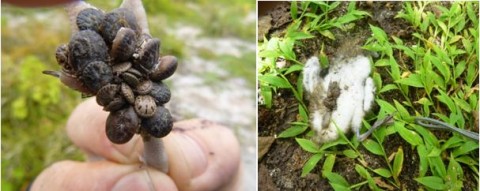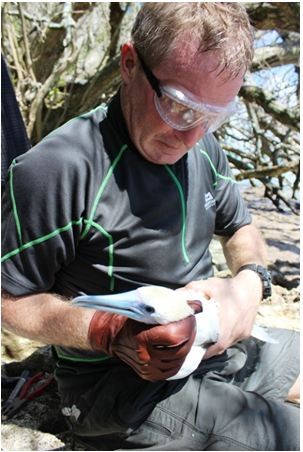BIOT Science Expedition 2014 - Pete Carr BIOT Science Expedition 2014 Initial Report Seabird IBAs
Long-term monitoring of Important Breeding Areas for Seabirds
Peter Carr, Permian Global
The primary aim was to continue long-term monitoring of internationally important breeding seabirds with the focus being on the ten designated and two proposed Important Bird Area (IBA) islands that hold > 98% of the breeding populations. Secondary aims were:
Initiate a Sooty Tern Onychoprion fuscatus study to analyse the breeding habitat requirements of this, the most numerous seabird in and, prime ecological indicator of the health of the Chagos Marine Protected Area (MPA).
Trial Mataki tracking devices on Red-footed Booby Sula sula to study their feeding and foraging behaviour throughout the Chagos MPA.
Monitor the spread of invasive species throughout the Chagos Archipelago.
General findings
Eleven of the twelve designated and proposed IBA islands were fully surveyed plus four other islands of ecological importance. Diego Garcia, the missing IBA was not surveyed due to time constraints, it taking five full days to cover the breeding colonies associated with this island. The seabirds were having a catastrophic breeding episode, caused primarily by the failure of Sooty Tern to successfully breed. The Sooty Tern breeding habitat study was successfully initiated but with limited numbers of chicks ringed due to the breeding failure mentioned above. The Red-footed Booby tracking project was initiated but was severely hampered by the time and location constraints imposed due to the necessity of meeting all scientists’ aspirations on the expedition. Notes on the spread of invasive species were taken, to be used to steer future terrestrial management plans. All are dealt with in greater detail below.
What these scientific research expeditions achieve for terrestrial monitoring is to provide a snap-shot of what is occurring at that time and this caveat is particularly relevant when interpreting dynamic events such as seabird breeding episodes. For the breeding seabirds of the Chagos the expedition surveys do not provide a definitive figure for the annual breeding populations, as they would in a northern hemisphere environment where there is a defined breeding season and the entire breeding population can be surveyed. This is because seabirds in the Chagos either breed throughout a calendar year or breed at less than 12 month intervals. Further, the lack of regular long-term monitoring (including at different times of the year) means that what data is gathered cannot be fully interpreted in a population trend context. This is because we do not know, for example, how often complete breeding failures as happened this expedition with Sooty Tern, actually occur. With these caveats in mind, a summary of the results of the key avian indicator species follows:
Long-term monitoring of Seabird Breeding
Sooty Tern Onychoprion fuscata: This species has had a catastrophic breeding episode. This should be the most numerous breeding seabird and over 100,000 breeding pairs is the annual expected norm on four to ten islands. This year (at least to date) 400 pairs bred on two islands. On Parasol in Peros Banhos 26% of chicks examined held avian parasitic ticks and the main colony of approximately 32,000 pairs deserted at the egg-laying stage. On Middle Brother, a survey in February 2012 recorded 32,000 breeding pairs. This year there were less than 300 pairs and these were also tick-infested but to a lesser degree (˃7%). It is unlikely that tick-infestation was responsible for lack of breeding on all islands.
Figure 23: Onychoprion fuscata breeding pairs recorded through February 1996 – April 2014.
It is clear from figure 23 that much data are lacking and an incomplete picture is presented. In July 2009 and August 2010 there were breeding episodes that would not have been recorded on “the annual” scientific expeditions. It is not known if breeding episodes occurred in years not surveyed and crucially, the context of the 2014 tick infestation cannot be assessed in a historical or episodic context.
Figure 24: a) An Onychoprion fuscata chick displaying a tick-infested foot. b) A dead Onychoprion fuscata chick with ticks.
Red-footed Booby Sula sula: The three largest breeding colonies (3,000+ pairs) are on Nelson and Danger Island and Diego Garcia and the total annual breeding population is in the region of 10,000-12,500 pairs. Diego Garcia was not surveyed on this trip as it takes at least five days to cover all the breeding area. Nelson’s Island held approximately 557 breeding pairs and Danger 400. Elsewhere there were 1169 breeding pairs. The total of 2,126 breeding pairs falls well short of the expected norm and is a cause for concern. However, this species has a north to south breeding gradient in that it nests earlier in the northern atolls than further south, therefore both Nelson’s and Danger Island have not reached peak breeding numbers yet. Further, some birds breed throughout the year and what oceanographic event(s) that trigger breeding is as yet unknown. Therefore, whilst there has been a decline in breeding numbers in comparison to previous surveys at this time of year, the true extent of the decline cannot be completely recognised without counts from later in this calendar year.
Wedge-tailed Shearwater Puffinus pacificus: Burrow-nesting shearwaters are notoriously difficult to accurately census, particularly when different counters are employed over the years. Dedicated shearwater researchers use state of the art heat-sensors or infra-red cameras to ascertain burrow occupancy. On the positive side, in the Chagos, with the exception of a tiny population on Diego Garcia, all shearwaters breed between November and April and therefore virtually the entire population can be counted by a one-off count in the right month. Even taking in to consideration the difficulties of accurately counting breeding shearwaters, there appears to have been a ≈ 66% decline in the breeding population since 2012. This figure is made more relevant by the fact that the same counter, using the same census method has counted the shearwater colonies since 2009.
Figure 25: Puffinus pacificus breeding pairs recorded through February 1996 – April 2014.
It is worth noting that Sooty Tern, Red-footed Booby and Wedge-tailed Shearwater are all deep water/pelagic feeders that are reliant to a certain degree on pelagic fish, i.e. tuna, to locate and catch prey. It is possible that the decline in numbers of these three species could be associated with problems with their pelagic feeding associates. This hypothesis would require further research to assess.
Brown Booby Sula leucogaster: This beautiful bird produced an annual record count of over 740 breeding pairs on North Brother, the majority at the egg-laying stage. There is one other large colony in the Chagos, on Danger Island. This colony only held 38 breeding pairs and these were all at the fledgling stage. In addition there were between 50-70 recently fledged juveniles hanging around the colony area. With the addition of smaller numbers breeding on three other islands the total Chagos breeding population in 2014 stands at approximately 850 pairs. This a significant portion of the total Indian Ocean population.
Lesser Noddy Anous tenuirostris: This species also appears to be sustaining its breeding population in the Chagos. It is problematical to survey due to an erratic/unknown breeding season. Counts throughout the year since 2008 have revealed an annual breeding population in the region of 35,000 – 40,000 pairs centred upon three major colonies on Nelson’s Island, South Brother and Petite Ile Bois Mangue and smaller colonies on many other islands. This year’s survey has coincided with breeding in these three main colonies and the total recorded has been comfortably above 35,000 pairs.
It is worth noting that Brown Booby and Lesser Noddy are regarded as inshore feeders and their present successful breeding status may be a reflection of the health of the banks, reefs and shoals of the Chagos MPA.
Common Noddy Anous stolidus: This species continues to be of grave concern in the Chagos. In the 1970’s, Nelson’s and Danger Island and Sea Cow each held terrestrial breeding populations of 10,000+. In 1996 there were c. 42,000 breeding pairs recorded. These numbers had declined to the low thousands by 2006 and terrestrial breeding had all but ceased by then. This situation has not changed and the annual breeding population has remained at under 2,000 pairs. Crucially, this species no longer breeds in dense colonies on the ground. It now breeds in isolation in trees. Whilst still common, the population is likely to be in very serious decline but has not manifested itself yet due to longevity.
Assessing the Breeding Habitat Requirements of the Sooty Tern Onychoprion fuscatus
The Sooty tern is the cornerstone of the designation of Important Bird Areas (IBAs) in the Chagos Archipelago with eight of the twelve IBAs being dependent upon this species for designation. However, surveys conducted since 2006 have demonstrated that not all islands are bred upon every year and Carr proposed in 2011 in British Birds and again in 2013 in Coral Reefs of the UKOTs that this designation system be changed to clusters of islands rather than individual islands. This system better reflects the bird’s actual use of the islands for breeding. This study aims to prove the shifting nature of the breeding colonies by individually ringing flightless chicks on breeding islands and then recapturing them at a later date in a breeding colony. This study was successfully started on the 2014 expedition with 135 chicks ringed on two breeding islands. It was hoped this figure would have been substantially greater but was hampered by the catastrophic breeding failure of this species during the period of the visit.
Testing Mataki Tracking Devices on Red-Footed Booby, Sula sula
The aim of this study is to track breeding Red-footed Booby on feeding and foraging flights to better understand their use of the Chagos MPA. It may also reveal pelagic fish movement in and through the MPA as Red-footed Booby is a near obligate-associate with pelagic fish when feeding. This trial was successfully started with devices attached to two adult birds. No data were derived from these tags but the experience gained from handling the birds and managing the tags will prove invaluable in this ongoing study.
Figure 26: Attaching a Mataki transmitter to an adult Red-footed Booby.
Conclusion
The surveys this year demonstrated this has been a season of highs and lows for breeding seabirds. The take-away point is if we are serious about conserving birds (and other terrestrial organisms) in the Chagos we have to understand their ecology, part of which is their breeding phenology. This aspiration is still a long way off and can only be achieved by regular surveys throughout the year over a long period of time. Only by knowing such simple things as when and where a seabird breeds, how often and in what numbers, what on an island is impacting their breeding and most important, what oceanographic events trigger breeding, will we really be able to implement effective conservation management plans. Sadly, time may be running out for effective conservation measures in the Chagos for Common Noddy and Sooty Terns.





